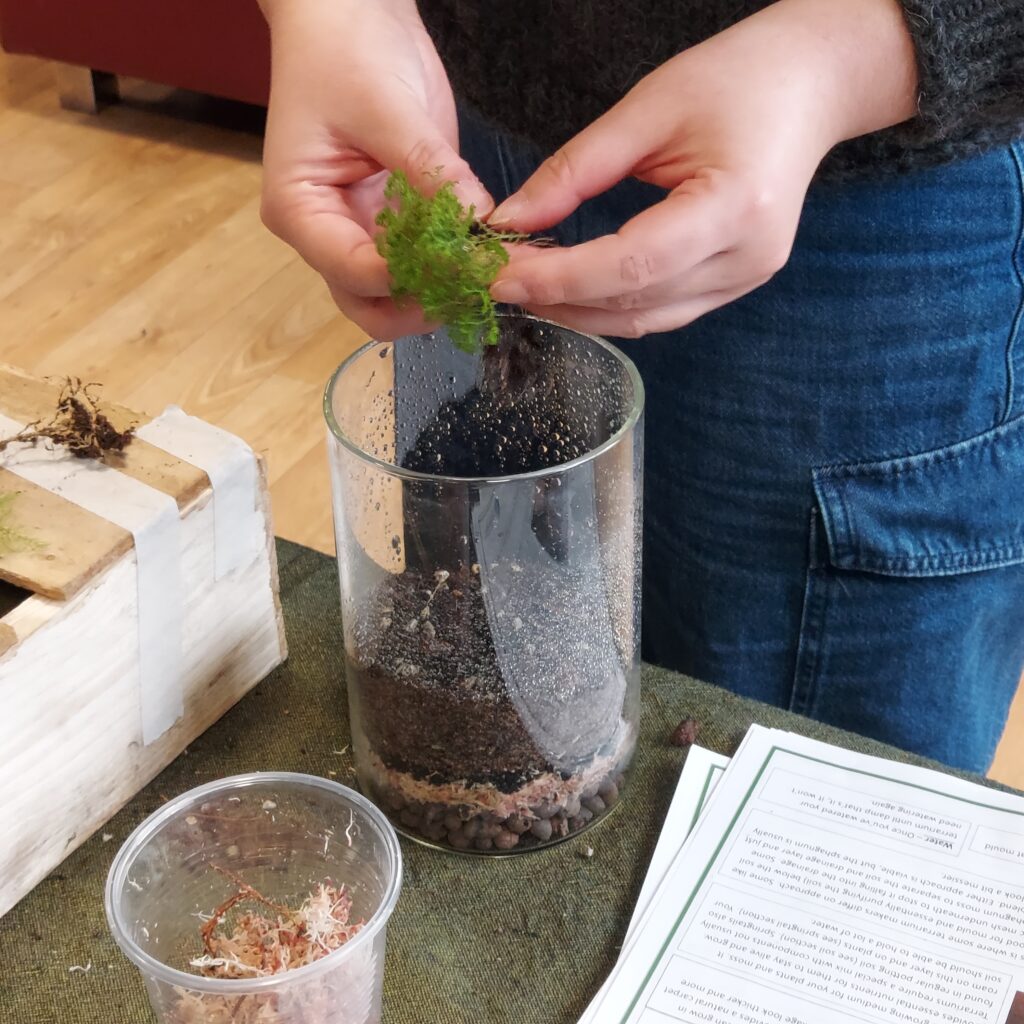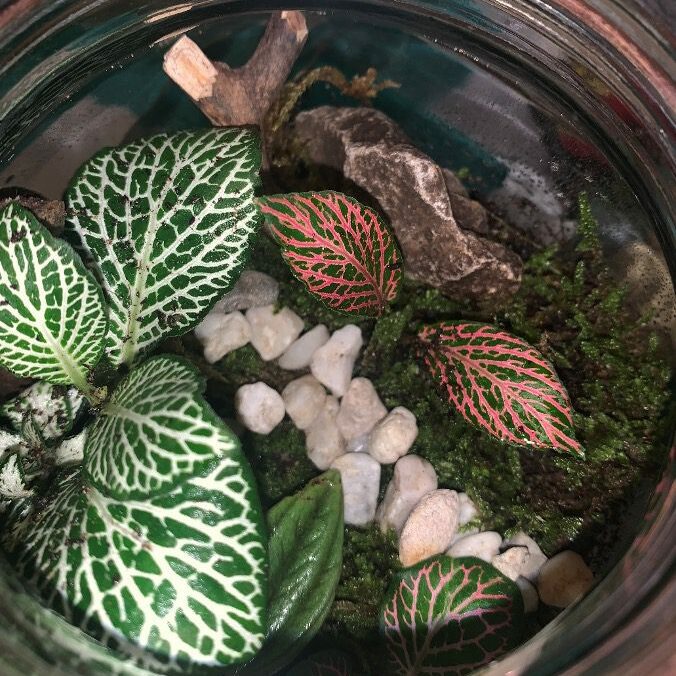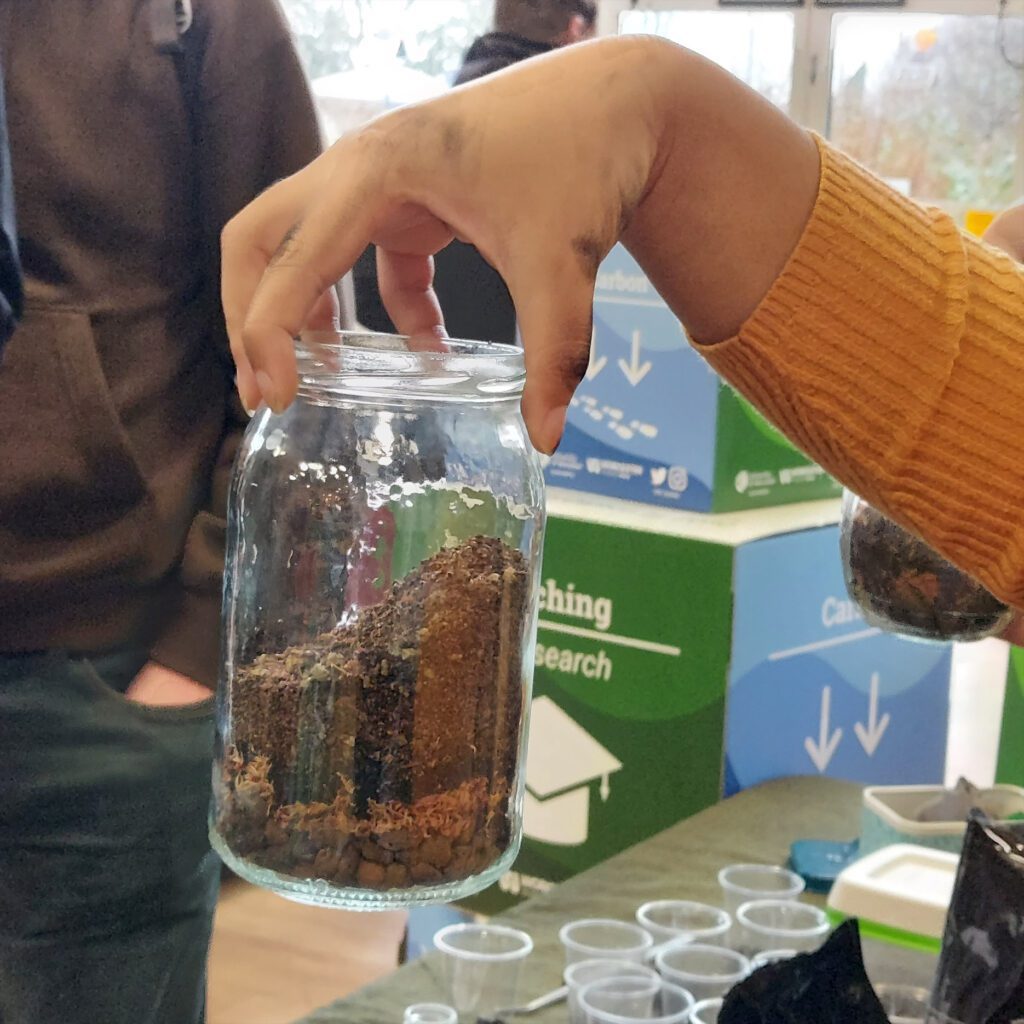Terrariums are self-contained tropical ecosystems that grow inside a closed container. This is a good example of sustainability, just in a bottle, jar, or vase. Written by Rosie Bramwell. Illustrated by Charlie Marston.
An interview with the two Worcester students – Mac Weekley and Elisha Parkes – who co-hosted the terrarium workshop

During our annual Go Green Week, students hosted a ‘Terrarium Making’ Workshop. This was a sold-out event that taught students and staff how to build and create their own terrariums.
Don’t worry if you missed out, more workshops are coming soon! But what is a terrarium? And how do you build one?
What are terrariums?
Mac Weekly: “Terrariums are closed tropical ecosystems where plants can grow in a container to create the look of a miniature rainforest biome.”
From my research, smaller terrariums are more likely to survive or less time but if well maintained and moved into larger containers, they can usually thrive just as long as bigger ones.”
A well-maintained terrarium can survive for years! Some have even survived as long as 60 years!
Although terrariums can be used for scientific observation and plant propagation – the process of growing more plants from a specific species – terrariums can be significantly beneficial for mental health! Indoor plants can purify and improve air quality in a closed space. While terrariums are self-contained, the presence and caring of a terrarium can be considered therapeutic.
Well-contained terrariums are not height maintenance when caring for them. Taking your time to build and tick every box will benefit you in the long run – take a look at our checklist below! Making sure there is enough moisture inside and indirect sunlight outside is all a small terrarium should need to survive.
The workshop at Go Green Week 2024

On the fourth day of our annual Go Green Week, sustainability enthusiastic students helped to host a small workshop in the Hanger on St Johns campus.
This workshop provided all of the materials and products needed for building a closed terrarium (see list below). The workshop was an incredible success, not only selling out of tickets but also with extra students turning up on the day.

MW: “[The workshop] more successful than we planned for! Our workshop spaces were booked up very quickly and then we had a lot of interest from passersby who all really enjoyed spontaneously building a terrarium and getting involved!”
Elisha Parkes: “I think the workshop was very successful people who participated seemed very happy with what they learned and made at the workshop. If we had the space and materials we could have allowed more people to participate as well.”
(More details on the next terrarium workshop are below!)
What made you interested in terrariums?
EP: “They’re interesting to learn about as well as a nice addition to my room that makes me happy to see it thriving.”
MW: “I’ve always been interested in the idea of creating something, but as I’ve never really had a knack or drawing or art, I struggled to find a creative output.”
When I stumbled across terrariums they fascinated me, something about the idea of creating a living breathing world was and always will be so cool to me! They also align with my love of nature and intrigue in sustainable practices.”
Bringing the process and the message together has allowed me to invest passion into a new hobby for myself and others.”
I was initially inspired by channels like Worcester Terrariums which made the process easy and accessible, with straightforward tutorials.”



What products do you need to build terrariums?
MW: “We make closed terrariums at the uni, but there are also closed ones, which contain more arid plants like cacti and succulents.”
Soil: Terrarium soil is different to the usual potting soil. It’s usually made to have high water retention with ingredients like coco coir, bark, charcoal, sphagnum moss, and peat-free substrate.
Plants: There are thousands of species of plants to use, tropical houseplants are the best. My favourites include fittonias, peperomias, pileas, ficus pumilam asparagus ferns and various epiphytes.
Springtails: These are tiny little bugs that eat mould and decay, and stop outbreaks from destroying the ecosystem. Systems only need a few for a whole colony to form.
Container with lid: A container of any size, with a well-fitting lid is essential to house your terrarium. Make sure its see through so you can see your plants!
Moss: Moss is the best way to make the terrarium look more lush and jungle-y. There are many species but my favourites are cushion, pillow, mood moss, and java moss. Moss is expensive but it can be grown or harvested in the wild (I do this!).
Charcoal: Can be mixed into the substrate and placed as a layer above the drainage layer. If it’s an activated charcoal this can help prevent mould from growing in your terrarium, otherwise, your springtails will snack on any mould or decay.
Sphagnum: Serves as a fantastic mediating layer between drainage and charcoal. It’s recommended to microwave it until it’s hot to kill it but keep its beneficial properties.
Drainage medium: For example, leca. This is a porous material to catches water at the bottom and serves as a failsafe if your terrarium is overwatered.
Hardscape: Elements like twigs and stone to make the terrarium look more natural.
How to build a terrarium:

- Place in your cleaned leca or drainage medium, only needed in a terrarium exceeding about 8oz in container size
- Place down a layer of dead sphagnum moss
- Place in a thin layer of charcoal
- Place in your soil
- Place in your moss
- Place in your plants, nestling them into the moss
- Place in any hardscape elements
- Add the springtails
- Done!
Top Tip: To look after terrariums (closed ones) keep them in constant indirect sunlight (by a window but not in the beams of sunlight). They shouldn’t need watering once made and watered during that process but if they do, use filtered or spring water. Open them weekly to allow airflow for 5 mins.
What are some common mistakes when building terrariums?

MW: “Always better to underdo it rather than overdo it, plants are surprisingly hardy when in terrariums. Overwatering them is a huge issue because it can lead to mould growth and rot. Taking water out of the soil is also an extremely difficult and tedious process.”

Using the wrong plants is common or putting in plants that require different conditions in order to live. Try to match up the plants and moss with similar maintenance conditions.”
EP: “When putting plants into my jar making sure the roots were planted correctly as the size of my jar was too small to fit my hand.”
Where and when the next one will be?
MW: “We have them planned regularly going forth, we’d like to aim for monthly. As for location, we don’t have specifics yet but we are in the process of hosting one for medical students so keep an eye out for that.”
The first workshop was successfully hosted in the Hangar, St Johns Campus as part of the annual Go Green Week. Future events are likely to be hosted in the new sustainability hub in the Thomas Telford building. As long as you book a ticket, materials and instructions will be provided on the day (we will let you know if you need to bring a container).

EP: “Yes there are definitely plans to put on more workshops in the future and at the moment we’re planning a workshop for the medical students.”
If people are interested in these being more workshops feel free to reach out on the Instagram uw_sustain or visit the sustainability hub for more stuff happening on sustainability.”
We will be posting *here* details for the next workshops as soon as they are confirmed! Keep checking back here or click the link in our Instagram bio to find tickets.
Workshop dates: Wednesday 10th April 3.00 pm-4.00 pm Location; Student Sustainability Hub, Thomas Telford Building St Johns Campus. Wednesday 15th May 3.00 pm-4.00 pm Student Sustainability Hub, Thomas Telford Building St Johns Campus.
Wednesday 15th May 3.00-4.00 pm Location: Student Sustainability Hub. Thomas Telford Building. St Johns Campus. Sign Up here
Want to read more? Check our posts Houseplants and Well-being for the benefits of owning and caring for plants, and Bird Watching for Well-Being by Heather Sykes!


